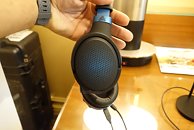- Joined
- Oct 9, 2007
- Messages
- 47,311 (7.52/day)
- Location
- Hyderabad, India
| System Name | RBMK-1000 |
|---|---|
| Processor | AMD Ryzen 7 5700G |
| Motherboard | ASUS ROG Strix B450-E Gaming |
| Cooling | DeepCool Gammax L240 V2 |
| Memory | 2x 8GB G.Skill Sniper X |
| Video Card(s) | Palit GeForce RTX 2080 SUPER GameRock |
| Storage | Western Digital Black NVMe 512GB |
| Display(s) | BenQ 1440p 60 Hz 27-inch |
| Case | Corsair Carbide 100R |
| Audio Device(s) | ASUS SupremeFX S1220A |
| Power Supply | Cooler Master MWE Gold 650W |
| Mouse | ASUS ROG Strix Impact |
| Keyboard | Gamdias Hermes E2 |
| Software | Windows 11 Pro |
If you've just experienced deja vu, it's because the HyperX Orbit S headset we went hands-on last evening packs Audeze-made planar magnetic drivers, and features head-tracking. Californian audiophile headphones and DAC maker Audeze fancies a bigger slice of the gaming audio pie, and has swan-dived into the competitive market with a feature-packed monstrosity, the Mobius.
The Audeze Mobius is an around-the-ear gaming headset that packs the company's finest 50 mm-class planar-magnetic drivers that have been tuned with a gaming-optimized sound-stage; and incorporates head-tracking positional audio technology, much like the HyperX Cloud Orbit S. On the software side of things, a virtual surround DSP takes in real-time input from the headset on the exact spatial position of your head compared to a static display (much like a VR HMD), and accordingly moves the audio perspective. The software is pretty intuitive and lightweight, and doesn't come with too much DSP bloat. We went ears-on with one of these, and the sound-quality blew our minds first, and the realism the head-tracking feature adds to gameplay took care of the rest. Head-tracking audio headsets could gain popularity among gamers who don't want a display within an inch of their eyes.





View at TechPowerUp Main Site
The Audeze Mobius is an around-the-ear gaming headset that packs the company's finest 50 mm-class planar-magnetic drivers that have been tuned with a gaming-optimized sound-stage; and incorporates head-tracking positional audio technology, much like the HyperX Cloud Orbit S. On the software side of things, a virtual surround DSP takes in real-time input from the headset on the exact spatial position of your head compared to a static display (much like a VR HMD), and accordingly moves the audio perspective. The software is pretty intuitive and lightweight, and doesn't come with too much DSP bloat. We went ears-on with one of these, and the sound-quality blew our minds first, and the realism the head-tracking feature adds to gameplay took care of the rest. Head-tracking audio headsets could gain popularity among gamers who don't want a display within an inch of their eyes.





View at TechPowerUp Main Site


